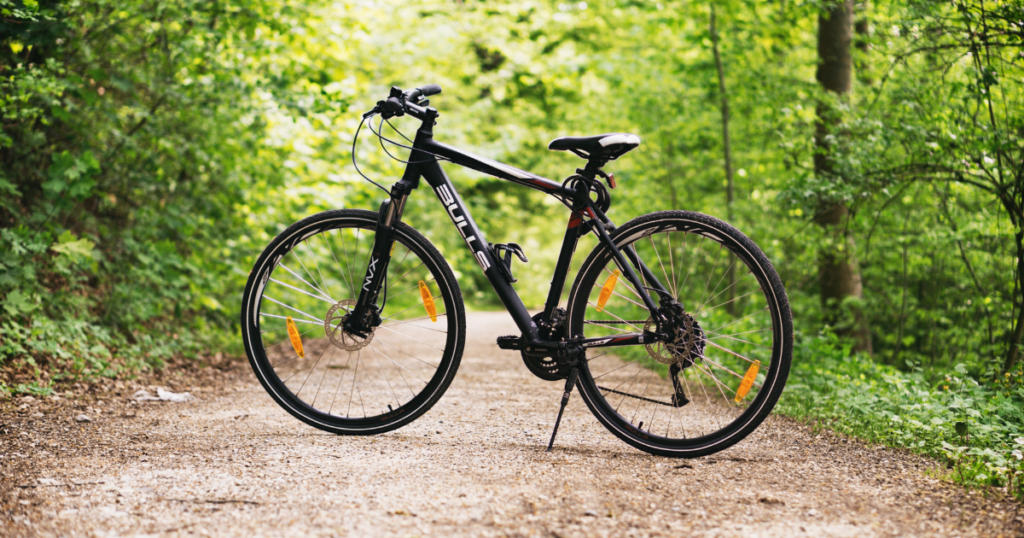If you’re a fan of BMX or looking to start freestyle biking, you might be wondering how much a BMX bike weighs. The weight of your bike can greatly impact your performance and maneuverability, whether you’re racing on dirt tracks or pulling off impressive tricks at the skate park. Finding the right balance between strength and agility is crucial.
In this blog post, we’ll cover everything you need to know about BMX bike weights – from what’s considered ideal to the factors that affect it. So grab your helmet and let’s dive into the exciting world of lightweight wonders and heavyweight beasts in BMX biking!
What is a good weight for BMX bike?
There isn’t a single answer that defines the perfect weight for a BMX bike. The ideal weight can vary based on factors like riding style, skill level, and personal preference. However, as a general guideline, most riders aim for a bike weighing between 20 to 30 pounds.
A lighter BMX bike provides several benefits in terms of agility and speed. It enables riders to perform tricks with greater ease and flexibility. Additionally, lighter bikes are easier to lift off the ground, making them ideal for executing impressive aerial stunts and jumps.
On the other hand, there are riders who actually prefer BMX bikes that are slightly heavier. This is because these bikes offer increased stability and durability. Heavier bikes are better equipped to handle rough terrains without sacrificing their structural integrity.
Choosing the appropriate weight for your BMX bike depends on understanding your personal riding style and preferences. If you prioritize executing technical tricks that demand precise control and agility, a lighter bike would be more suitable. However, if you’re into racing or enjoy conquering tough terrains like dirt tracks or high-speed ramps, opting for a slightly heavier option could offer greater stability.
It’s important to keep in mind that these guidelines are just suggestions. There isn’t a universal “perfect” weight for every BMX bike. It’s essential to try out different weights and find what feels most comfortable and intuitive for you as a rider.
The average BMX bike weighs between 20 and 30 pounds
When it comes to BMX bikes, weight plays a crucial role. A lighter bike enables easier execution of tricks and maneuvers, while a heavier bike can offer increased stability and durability. But what exactly is considered an optimal weight for a BMX bike?
BMX bikes typically weigh between 20 and 30 pounds. It’s worth mentioning that the weight of a BMX bike can vary based on factors like size, construction materials, and intended use.
The weight of a BMX bike is influenced by its size. Bikes designed for younger riders are typically lighter compared to those built for adults. This is because smaller frames and components are needed for smaller riders.
When selecting a BMX bike based on weight, it’s important to take into account the rider’s skill level and intended use. For beginners or riders who prioritize durability over performance, slightly heavier options that can withstand rough treatment may be preferred.
If you want to make your BMX bike lighter or personalize it to your liking, there are a few methods you can use to accomplish this:

Choose lightweight materials:
Choosing frames made from aluminum or carbon fiber, rather than steel, significantly reduces the overall weight while maintaining strength.
2. Select lighter components:
To reduce the weight of a bike, you can consider upgrading certain parts like handlebars, forks, cranks, pedals, and wheels. Opting for lighter alternatives made from materials such as titanium or magnesium can help in achieving this goal.
3. Trim unnecessary accessories:
Remove any unnecessary accessories like pegs or reflectors that add extra bulk without serving much purpose.
4. Go tubeless:
Making the switch from standard tires with tubes to tubeless setups offers two major advantages. Firstly, it reduces rotational mass, making your ride more efficient and effortless. Secondly, it completely eliminates the possibility of experiencing pinch flats, providing
It’s important to note that different types of BMX bikes have different weights because of their specific design purposes.
– Street/Park Bikes:
These bikes are typically more robust and can weigh towards the higher end of the 20-30 pound
The impact of size on bike weight
The weight of a BMX bike is influenced by its size. In general, smaller bikes are lighter compared to larger ones. This is because smaller frames require less material, resulting in less overall weight.
BMX bikes come in different sizes to suit riders of varying heights and preferences. The most commonly available sizes include 20-inch, 24-inch, and occasionally even 26-inch frames.
The standard size for most BMX bikes is 20 inches, which is suitable for riders of average height. These bikes are specifically designed to prioritize agility and maneuverability, making them perfect for performing tricks and jumps.

In contrast, larger frame sizes like 24 or 26 inches are usually selected by taller riders or individuals who prefer a more stable riding experience. These bikes may be slightly heavier due to their larger dimensions.
Keep in mind that smaller frames may provide a weight advantage, but they may not be as comfortable or appropriate for taller individuals. It’s crucial to select a bike size that suits your body proportions and riding style instead of solely considering weight.
When looking to buy a BMX bike, it’s important to factor in the impact of size on weight. Generally, smaller frames will result in lighter bikes. However, it’s essential to strike the right balance between comfort and performance based on your individual needs as a rider.
Choose a BMX bike based on the rider’s
When deciding on a BMX bike, it’s crucial to consider the size and skill level of the rider. The weight of the bike is especially important, as both an excessively heavy or lightweight bike can significantly affect the rider’s performance and overall experience.
If you’re a younger rider or just starting out, it’s typically advised to go for a slightly lighter bike. This will give you better control and maneuverability, making it easier to learn new tricks and techniques. On the other hand, if you’re more experienced, you may prefer a slightly heavier bike. This provides added stability and durability when tackling more advanced tricks and jumps.
It is important to find the right frame size to ensure a perfect fit for the rider. Taller individuals may find larger frames more suitable, while shorter riders often prefer smaller frames. Matching your body type with the appropriate BMX bike will greatly enhance comfort and improve your overall riding experience.
When choosing a BMX bike, it’s important to consider the rider’s size. This ensures that they can experience optimal performance and safety during their biking adventures. It’s not just about skill level; factors such as height, weight, and personal preferences should also be taken into account when selecting the perfect ride for you!
Ways to Reduce Weight of BMX Bike
Having a lightweight bike can greatly enhance your performance in BMX biking. Here are some effective methods to reduce weight and optimize your ride.
Choose Lighter Components:
To make your bike lighter, start by choosing lighter components such as handlebars, forks, and cranks. Opt for materials like carbon fiber or titanium that provide strength without adding excessive weight.
2. Streamline Your Frame:
When choosing a frame, it’s worth considering options with minimal tubing and cutouts. This helps to reduce weight without compromising the overall structural integrity. Additionally, look out for frames that are made from lightweight alloys or composites.
3. Upgrade Your Wheels:
To increase maneuverability on the track or street, consider investing in lighter rims and spokes. This will help decrease rotational weight, allowing for better handling and performance.
4. Trim Excess Accessories:
Consider whether accessories like pegs or rotor systems are truly necessary for your bike. Removing any non-essential items can help reduce unnecessary bulk and lighten the overall load.
5. Optimize Tire Size:
If you opt for narrower tires, you can effectively reduce rolling resistance and overall weight without sacrificing grip.
6. Use Lightweight Bolts:
To instantly reduce weight without compromising durability, consider replacing standard bolts with titanium alternatives.
Keep in mind that every gram matters in BMX biking! By incorporating these tactics, you can build a lighter bike that will enhance your riding experience to new levels.
The Materials of the BMX Bike
The materials used in constructing a BMX bike play a significant role in determining its weight. Manufacturers carefully select materials that offer both durability and lightness to enhance the overall performance of the bike.
A popular choice for BMX frames is chromoly steel, which is well-known for its high strength-to-weight ratio. These frames offer exceptional durability without adding excessive weight. Another option is aluminum alloy, which is lightweight yet still provides sturdy construction.
When it comes to components like handlebars and forks, many people prefer using lightweight aluminum alloys. However, carbon fiber parts are also becoming popular in high-end BMX bikes because they offer both exceptional strength and reduced weight.
The weight of a BMX bike is influenced by various factors, including the type of rims, tires, pedals, and seat post used. Opting for lightweight rims made from aluminum or carbon fiber can effectively reduce rotational mass and enhance maneuverability.

Selecting the appropriate materials is essential when it comes to finding the perfect balance between weight and durability for a BMX bike. By incorporating advanced elements like chromoly steel or carbon fiber, riders can experience a lighter ride while maintaining strength and optimal performance.
Weight of Different Types of BMX Bikes
The performance of BMX bikes greatly depends on their weight. Various types of BMX bikes have different weights, which are determined by their intended use and the materials used in their construction.
There are two main types of BMX bikes: park and street bikes. Park BMX bikes are specifically designed for performing tricks and stunts in skate parks or urban environments. These bikes are built to be lightweight, usually weighing between 20-25 pounds. The lightness allows riders to achieve maximum airtime and maneuverability while performing aerial tricks.
Moving on to dirt jump BMX bikes, these are specifically designed for off-road jumps and trails. They are slightly heavier than park models because they need to withstand harsh landings and rough terrains. Typically, dirt jumpers weigh between 25-30 pounds.
Next, we have BMX bikes designed for competitive racing on tracks. These specialized bikes are incredibly lightweight, weighing in at just 15-20 pounds! The main focus of these bikes is speed, so every ounce makes a difference when sprinting towards the finish line.
There are freestyle or flatland BMX bikes that excel at intricate balance-based tricks performed on smooth surfaces like parking lots or indoor arenas. While not as light as race-specific models, freestyle/fatland bicycles generally fall within the 25-30 pound range.
Keep in mind that the weight ranges provided are general and can vary based on factors such as frame size, components utilized (such as forks or handlebars), tire thickness (lighter tires can decrease overall weight), and personal modifications made by individual riders.
Lightweight BMX Bikes vs. Heavyweight BMX Bikes
The weight of a BMX bike significantly affects its performance. Riders are increasingly drawn to lightweight BMX bikes due to their enhanced agility and maneuverability. These bikes are constructed with materials that prioritize reducing weight while maintaining strength.
A significant benefit of lightweight BMX bikes is their ability to effortlessly perform tricks and jumps. The decreased weight enables riders to achieve greater airtime and execute complex maneuvers with ease. Whether you’re riding ramps or grinding rails, a lighter bike can significantly enhance your overall performance.
In contrast, heavyweight BMX bikes prioritize stability and durability. They are designed to withstand tough terrains and heavy impacts, making them ideal for street riding or dirt jumping. While they may not offer the same level of agility as lighter options, heavyweight BMX bikes provide a reliable foundation for riders who value stability over maneuverability.
The choice between a lightweight or heavyweight BMX bike ultimately comes down to your riding style and personal preferences. If you’re mainly focused on performing technical tricks or participating in competitions, a lightweight bike would be the ideal option. On the other hand, if you prefer riding on rugged terrains or need extra durability for intense sessions at the park, a heavier bike might be more suitable for you.
Keep in mind that every rider has unique requirements when it comes to the weight of their BMX bike. It’s crucial to take into account factors like skill level, terrain type, and personal preference before making your choice. So, whether you opt for a lightweight or heavyweight option, make sure to ride with enthusiasm and enjoy yourself!
Factors Affecting BMX Bike Weight
The weight of a BMX bike can be influenced by various factors, with the materials used in its construction being one of the key considerations. Different materials have different weights, which significantly impacts the overall heaviness or lightness of the bike.
For instance, bikes constructed from steel are generally heavier compared to those made from aluminum or carbon fiber. While steel frames offer sturdiness and longevity, they can contribute additional pounds to the bike’s overall weight. Conversely, aluminum frames are lighter but may compromise on durability.
BMX bike weight is also influenced by the components used. Factors such as the type of wheels, tires, handlebars, and even pedals can all play a role in determining how heavy or light a bike feels. High-quality components made from lightweight materials like titanium or magnesium can help reduce weight but typically come at a higher cost.
The weight of a BMX bike is influenced by its size and dimensions. Bigger frames generally weigh more because they require additional materials for support. Furthermore, longer handlebars or wider tires can also contribute to the overall weight by adding extra grams.

In addition, adding extra accessories or modifications to the bike will also increase its overall weight. Accessories such as pegs for performing grinding tricks or heavier seat posts for enhanced stability all play a role in making the bike heavier.
How Much Does Custom Built BMX Bike Weigh?
Custom-built BMX bikes allow riders to create a bike tailored specifically to their needs and preferences. The weight of a custom-built BMX bike depends on the components selected by the rider.
The weight of a custom-built BMX bike is primarily influenced by the choice of materials. For instance, selecting a lightweight aluminum frame instead of steel can significantly decrease the overall weight. Likewise, opting for lighter alloy rims and spokes in place of heavier steel ones can also have an impact on reducing weight.
Another way to reduce weight is by choosing lighter components such as handlebars, forks, and pedals. Cyclists who value speed and agility often prefer these lightweight options.
It is worth mentioning that although using lighter components in certain areas like jumps or tricks may enhance performance, they may not be as durable as their heavier counterparts. It is important to find a balance between reducing weight and ensuring durability based on your specific riding style and preferences.
Riders can customize BMX bikes to meet their specific needs by selecting the materials and components that work best for them. This allows for a personalized riding experience. The weight of the bike will vary depending on these choices, so it’s important to find the right balance between lightness and durability based on your riding style.
How To Make Your BMX Bike Lighter?
If you want to improve your performance in BMX biking, one of the key factors is having a lighter bike. A lighter bike enables quicker acceleration, easier maneuverability, and better control. So if you’re aiming to reduce the weight of your BMX bike, here are some valuable tips that can assist you in achieving your goal.
To make your bike lighter, you can try swapping out heavier parts for lighter ones. Begin with the wheels – choosing lightweight rims and low-profile tires can greatly reduce the overall weight of your bike. Moreover, upgrading to a lighter fork and handlebars can make a noticeable impact.
Now, let’s assess your drivetrain. Opting for a lightweight chainring and cassette can effectively reduce unnecessary weight while still maintaining durability and strength. Additionally, consider upgrading your pedals to aluminum or magnesium ones to further shed some grams.
To make your BMX bike lighter, consider opting for lighter materials in certain parts of the frame. Titanium frames are renowned for their strength-to-weight ratio, although they do come at a higher price point. Alternatively, carbon fiber frames provide excellent stiffness and lightness but may also be more costly.
Take a look at any accessories or modifications on your bike that may not be necessary and could be adding extra bulk. For instance, removing reflectors or streamlining brake setups can help reduce weight without compromising safety.
When aiming to make your BMX bike lighter, remember that even small weight reductions can have an impact. However, it’s important to prioritize functionality and ensure that any alterations made maintain the bike’s ride quality and overall performance.
Should I Buy a Lighter BMX Bike?
When selecting a BMX bike, the weight of the bike is an essential factor to consider. A lighter bike can greatly impact your riding experience and performance. However, it’s important to carefully weigh the pros and cons before deciding whether to purchase a lighter BMX bike.
Owning a lighter BMX bike has a significant advantage – it enables greater maneuverability. With reduced weight to handle, performing tricks, jumps, and spins becomes easier, allowing for precise control and enhancing your riding skills to the next level.
A lighter BMX bike can also improve your speed and agility when riding on the track or street. It allows you to accelerate quicker coming out of turns and maneuver through tight corners more effectively. This can give you a competitive advantage in races or simply make your casual rides more enjoyable.
However, it’s important to consider the downsides as well. Lightweight BMX components often come at a higher price compared to their heavier counterparts. So if you have budget constraints, investing in a lighter BMX may not be practical for you.
Additionally, it’s important to consider that lightweight bikes, although they provide better handling, may compromise on durability because of the use of materials like carbon fiber or titanium. If you ride aggressively or frequently encounter rough terrain or big drops, prioritizing durability over weight savings might be a better choice for your specific requirements.
When it comes to purchasing a lighter BMX bike, your personal preferences and riding style should be the driving factors. Consider aspects like budget limitations, intended usage (whether for racing or freestyle), and your priority between maneuverability and durability before settling on your final choice.
When choosing your ideal ride, it’s important to find the right balance between weight reduction and functionality. Whether you prefer a featherlight option or something slightly heavier but built tough, consider what suits your needs best.

Is There A Weight Limit For BMX Bikes?
Riders often have questions about weight limits for BMX bikes. The reality is that there is no universally defined weight restriction for these bikes. However, it’s crucial to remember that each bike has its own limitations and capabilities.
BMX bikes are specifically designed to endure the demands of tricks, jumps, and stunts. Manufacturers carefully consider the forces that these activities place on the bike, ensuring its strength and durability. While most BMX bikes can accommodate various rider weights, exceeding their intended limits may lead to reduced performance or even damage.
When choosing a BMX bike, it’s important for riders to take into account their weight and riding style. Heavier riders may benefit from a stronger frame with thicker tubing or reinforced components. Likewise, riders who frequently perform high-impact maneuvers should select a bike that can withstand the added stress.
Don’t forget, selecting the correct size and type of bike is crucial. It’s always a good idea to seek guidance from experts at your nearby bicycle store. They can offer personalized recommendations that suit your specific requirements.
Although there is no official weight limit for BMX bikes, it is important to choose a bike that suits your body type and riding style. Understanding how factors like frame construction and component materials affect overall strength is key to ensuring optimal performance while prioritizing safety during your adventures, whether you’re cruising through streets or catching air on ramps!
Final thoughts
The weight of a BMX bike is influenced by various factors, including the materials used in its construction and the size and riding style of the cyclist. These factors collectively determine the overall weight of a BMX bike.
When it comes to determining the ideal weight for a BMX bike, it’s crucial to understand that there is no universal answer. The perfect weight will differ based on each rider’s individual preferences and requirements.
If you’re aiming for speed and agility, choosing a lighter BMX bike can be advantageous. These bikes usually weigh between 20 and 25 pounds, allowing for easier maneuverability and trick performance.
If you prioritize strength and durability, a heavier BMX bike may be the ideal choice for you. These bikes can weigh over 30 pounds, providing increased stability and resilience.
When it comes to choosing the weight for your BMX bike, personal preference and intended use should be the guiding factors. Take into account factors such as your riding style, skill level, and desired performance outcomes before making a decision.
When considering reducing weight on your BMX bike for improved performance, it’s important to prioritize safety and structural integrity. Avoid compromising these factors in the pursuit of shedding unnecessary pounds.
FAQs: A BMX Bike Weigh
1. What is a good weight for a BMX bike?
The ideal weight of a BMX bike varies based on the rider’s personal preference and riding style. Typically, a lighter bike weighing around 20-25 pounds offers enhanced maneuverability, making it easier for riders to perform tricks. However, some riders might prefer slightly heavier bikes as they provide added stability during rides.
2. How much does an average BMX bike weigh?
The average weight of a standard BMX bike ranges between 20 and 30 pounds. This weight includes the frame, components, wheels, and other parts.
3. Does the size of the rider affect the weight of the BMX bike?
The weight of a BMX bike can indeed be affected by the size of the rider. Larger riders often need stronger frames and components, which can result in added weight to their bikes.
4. Can you reduce the weight of a BMX bike?
Yes! There are several ways to reduce the weight of your BMX bike:
– Choose lightweight materials such as aluminum or carbon fiber for your frame.
– Opt for lighter components like handlebars, stems, forks, pedals etc.
– Use lighter tires with thinner sidewalls.
– Consider removing any unnecessary accessories or parts that you do not need.
5. Are there different types of materials used in making BMX bikes?
Sure, there are various materials used in the construction of BMX bikes. Some common options include steel, aluminum alloy, chromoly (a specific type of steel), and carbon fiber composite.
6. Are lightweight or heavyweight bikes better for BMX riding?
Lightweight bikes are advantageous for tricks and racing because they provide greater agility and easier maneuverability.
When it comes to jumps or rough terrains where strength is crucial, heavyweight bikes are the way to go. They offer increased durability and stability, prioritizing resilience over speed.
7. Is there a maximum weight limit for BMX bikes?
BMX bikes do not have a strict weight limit.






3 thoughts on “How Much Does A BMX Bike Weigh?”